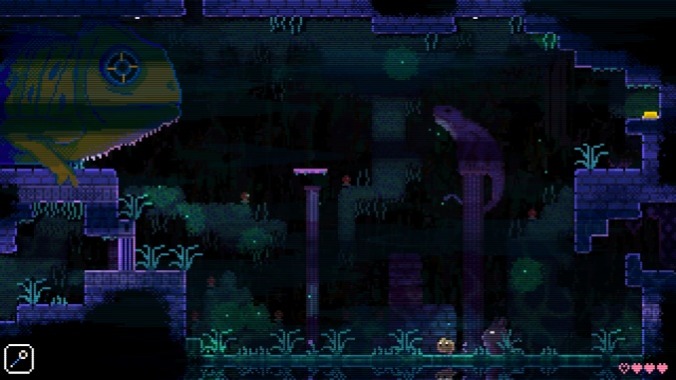Animal Well Is an Atmospheric Puzzle Platformer that Delights in Discovery

Sometimes, it feels like we can get a little too caught up on using genre as the end-all-be-all for describing games. At first glance, Animal Well, a game from solo dev Billy Basso, seems to fit into the same bucket as other Metroid-inspired romps: it’s a retro-tinged 2D platformer with a large overworld where you find items that encourage you to backtrack through areas you’d previously traversed. This overview is technically accurate but neglects to mention that thanks to its layers of well-considered mystery, this experience has more in common with the cryptic and rewarding puzzle-solving of Fez or Tunic than the action-packed adventures of Samus Aran.
Because instead of playing as a badass bounty hunter armed to the teeth with futuristic weaponry, you play as a goopy little ball incapable of taking out a lowly Geemer, let alone Mother Brain. Instead of improving your lethality, the tools you find along the way help you with solving puzzles, which range from quick and easy minor challenges, to world-spanning enigmas that will have you spiraling until you’re drawing up convoluted evidence board full of half-solved riddles. In short, this adventure isn’t about fights but about uncovering secrets, a dark wonderland full of strange locales and ego-inflating eureka moments that make for a deeply captivating journey.
Things begin as the protagonist, an unnamed orb with shoes, wakes up (or is born?) from a bulb. There is no explicit explanation for what to do next, and there isn’t exposition or dialogue to set the stage for who they are and what they want. Instead, you simply start poking around, solving simple platforming puzzles involving glowing yellow buttons as you encounter strange sights that won’t fully click into place until hours and hours down the line. The map is open from the beginning, with the only impediments to your progress being the absence of specific tools or knowledge. However, even compared to many other games in this style, things are quite open from the jump, with multiple directions to explore that grant a satisfying degree of freedom.

The puzzles you encounter while exploring come in layers, with the first being made up of relatively straightforward single-screen challenges that usually require some light platforming. Additionally, you’ll frequently find hidden pathways that lead to collectibles. These smaller trials, both the optional and mandatory ones, are fun and fill out the space, acting as a fitting complement to the exploration. It also helps that the platforming is quite snappy, especially when combined with later abilities that allow for clever traversal.
However, where things inspired a deeper curiosity, and at least in my case, an all-consuming obsession with unraveling these mysteries, was how these smaller puzzles tied into much bigger ones. In many areas, you’ll find landmarks that feel like they have a greater meaning, and they frequently do. I found myself jotting down notes and cataloging strange sights like an amateur archeologist way out of their depth until, eventually, these signs and ciphers began to make sense. The scope of these riddles and the lack of direct guidance made cracking them immensely satisfying, and the clues strike a good balance between being too obscure and too obvious.
While the game doesn’t teach you with explicit instruction, it does subtly craft scenarios that naturally lead to incredible discoveries, many of which had me literally yelling out loud as I finally solved some longstanding problem. Much of the trickier stuff is “optional,” in the sense that you can get to the credits without engaging with it, but even the mainline material comes with plenty of moments that make you feel like a detective or researcher who finally lands on a monumental find. Thanks to its open-ended qualities and absence of direct guidance, it all builds toward a few of the most gratifying revelations I’ve experienced in a game in recent memory.
